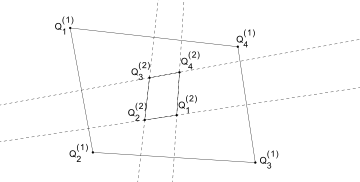Perpendicular bisector construction of a quadrilateral
In geometry, the perpendicular bisector construction of a quadrilateral is a construction which produces a new quadrilateral from a given quadrilateral using the perpendicular bisectors to the sides of the former quadrilateral. This construction arises naturally in an attempt to find a replacement for the circumcenter of a quadrilateral in the case that is non-cyclic.
Definition of the construction
Suppose that the vertices of the quadrilateral  are given by
are given by  . Let
. Let  be the perpendicular bisectors of sides
be the perpendicular bisectors of sides  respectively. Then their intersections
respectively. Then their intersections  , with subscripts considered modulo 4, form the consequent quadrilateral
, with subscripts considered modulo 4, form the consequent quadrilateral  . The construction is then iterated on
. The construction is then iterated on  to produce
to produce  and so on.
and so on.

An equivalent construction can be obtained by letting the vertices of  be the circumcenters of the 4 triangles formed by selecting combinations of 3 vertices of
be the circumcenters of the 4 triangles formed by selecting combinations of 3 vertices of  .
.
Properties
1. If  is not cyclic, then
is not cyclic, then  is not degenerate.[1]
is not degenerate.[1]
2. Quadrilateral  is never cyclic.[1] Combining #1 and #2,
is never cyclic.[1] Combining #1 and #2,  is always nondegenrate.
is always nondegenrate.
3. Quadrilaterals  and
and  are homothetic, and in particular, similar.[2] Quadrilaterals
are homothetic, and in particular, similar.[2] Quadrilaterals  and
and  are also homothetic.
are also homothetic.
3. The perpendicular bisector construction can be reversed via isogonal conjugation.[3] That is, given  , it is possible to construct
, it is possible to construct  .
.
4. Let  be the angles of
be the angles of  . For every
. For every  , the ratio of areas of
, the ratio of areas of  and
and  is given by[3]
is given by[3]
5. If  is convex then the sequence of quadrilaterals
is convex then the sequence of quadrilaterals  converges to the isoptic point of
converges to the isoptic point of  , which is also the isoptic point for every
, which is also the isoptic point for every  . Similarly, if
. Similarly, if  is concave, then the sequence
is concave, then the sequence  obtained by reversing the construction converges to the Isoptic Point of the
obtained by reversing the construction converges to the Isoptic Point of the  's.[3]
's.[3]
References
- ↑ 1.0 1.1 J. King, Quadrilaterals formed by perpendicular bisectors, in Geometry Turned On, (ed. J. King), MAA Notes 41, 1997, pp. 29–32.
- ↑ G. C. Shephard, The perpendicular bisector construction, Geom. Dedicata, 56 (1995) 75–84.
- ↑ 3.0 3.1 3.2 O. Radko and E. Tsukerman, The Perpendicular Bisector Construction, the Isoptic Point and the Simson Line of a Quadrilateral, Forum Geometricorum 12: 161–189 (2012).
- J. Langr, Problem E1050, Amer. Math. Monthly, 60 (1953) 551.
- V. V. Prasolov, Plane Geometry Problems, vol. 1 (in Russian), 1991; Problem 6.31.
- V. V. Prasolov, Problems in Plane and Solid Geometry, vol. 1 (translated by D. Leites), available at http://students.imsa.edu/~tliu/math/planegeo.eps.
- D. Bennett, Dynamic geometry renews interest in an old problem, in Geometry Turned On, (ed. J. King), MAA Notes 41, 1997, pp. 25–28.
- J. King, Quadrilaterals formed by perpendicular bisectors, in Geometry Turned On, (ed. J. King), MAA Notes 41, 1997, pp. 29–32.
- G. C. Shephard, The perpendicular bisector construction, Geom. Dedicata, 56 (1995) 75–84.
- A. Bogomolny, Quadrilaterals formed by perpendicular bisectors, Interactive Mathematics Miscellany and Puzzles, http://www.cut-the-knot.org/Curriculum/Geometry/PerpBisectQuadri.shtml.
- B. Grünbaum, On quadrangles derived from quadrangles—Part 3, Geombinatorics 7(1998), 88–94.
- O. Radko and E. Tsukerman, The Perpendicular Bisector Construction, the Isoptic Point and the Simson Line of a Quadrilateral, Forum Geometricorum 12: 161–189 (2012).
